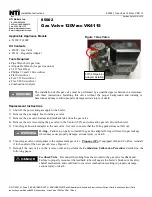
10
WHAT IS THE PROBLEM?
WHY IS IT HAPPENING?
HOW TO FIX IT?
Alcohol distillate flows
irregularly.
•
Wash is surge boiling caused by hot spot
on base of integrated boiler.
•
Spirit outlet pipe is higher than outlet
creating an airlock or is submerged in
distillate causing alternating pressure
and vacuum.
•
Add ceramic boil enhancers. In extreme
cases try adding 1–2 stainless steel pot
scrubbers.
•
Make sure the outlet pipe allows the
water to flow downwards from the
condenser outlet.
Trim outlet pipe so that it cannot
be below the level of the collected
distillate.
No alcohol is coming out.
•
This may be due to the cooling water
being too cold or its flow rate too high.
•
This may be due to an incorrect position
of the tubes.
•
There may be a blockage at the end of
your alcohol outlet tubing.
•
Ensure the cooling water outlet
temperature is between 50-65°C
(122-149°F) during distillation.
•
Check the tubes are in the correct
position (refer to Step 2 and 3).
•
Remove the plug at the end of your
alcohol outlet tubing.
The spirit is coming out
cloudy/milky.
•
Wash is foaming while boiling and
carrying fermentation residues up the
column.
•
Unfermented sugar in your wash can
cause foaming which eventually made its
way up into the condenser causing the
temperature fluctuations and producing
undesirable, cloudy spirit.
•
Always ensure your wash is completely
fermented (refer to Step 1 on
fermentation).
•
Only fill wash to MAX line on inside
of boiler if using the 30 L (8 US Gal)
boiler. The 4.9 L (1.3 US Gal) boiler has
more tolerance and can be filled up to
8 L (2.1 US Gal).
•
Add 3 capfuls of Still Spirits Distilling
Conditioner to the wash. This stops
excessive foaming in the boiler.
•
Add ceramic boil enhancers in your
boiler. Re distil the bad spirit.
Spirit has a strong
unpleasant smell,
described as ‘paint
thinner’, ‘hospital’, ‘burnt’,
‘nail polish’.
•
Distillate coming out of the Turbo 500
is at approx 93% ABV and has a strong
ethanol smell.
•
The first 50 ml (2 US fl oz) of distillate
has a stronger smell (nail polish type),
because it contains most acetaldehydes
and esters. This should be discarded.
•
The rest of the distillate smells like
ethanol.
•
Water down and filter your distillate
with activated carbon. It will trap most
unwanted flavours, leaving you a clean
spirit (refer to activated carbon in the
glossary).
Spirit has a blue tint.
•
This is caused by unbalanced or excessive
nutrients added in the fermentation
vessel. Nutrients are essential for
the yeast to ferment sugars; they are
precisely dosed and included in every Still
Spirits Turbo Yeast sachet.
•
Use only 1 sachet of Still Spirits Turbo
Yeast per 25 L (6.6 US Gal) of wash.
•
Follow recommended recipes for each
type of Turbo Yeast.
The yield is low.
•
The wash has not fermented out
properly so the amount of alcohol
available is reduced. This could be due
to several factors:
•
The sugars were not fully dissolved.
•
The fermentation temperature is too low
or too high.
•
Steam and vapour pressure is leaking
from lid seal.
•
Check the fermentation is finished
(refer to FAQs about fermentation).
•
Check lid gasket is sitting evenly inside
lid before clipping onto the base.
TROUBLE SHOOTING GUIDE


































